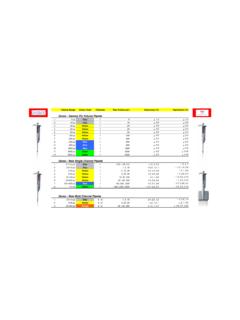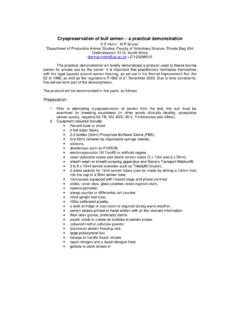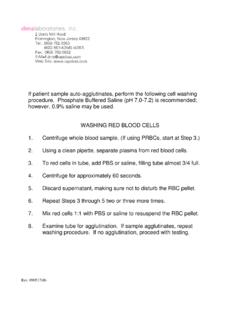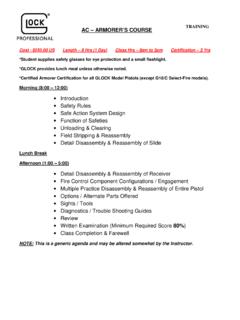Transcription of SETTING TOLERANCES IN A PIPETTE CALIBRATION PROGRAM
1 Calibrate, Inc. | | 1-800-253-7064 Calibrate, Inc. 610 Jones Ferry Rd. Ste 210 Carrboro, NC 27510 919-240-4032 By: Ann Lenhardt, COO/Director of QA SETTING TOLERANCES IN A PIPETTE CALIBRATION PROGRAM As a vendor of CALIBRATION , Calibrate is frequently asked by our clients and other interested parties for advice and support with regard to the SETTING of TOLERANCES for the CALIBRATION of pipettes and bottle top dispensers. Today s PIPETTE users are often required to collect and analyze data regarding the performance of each PIPETTE , and the decision as to where to set the pass-fail criteria is a critical component of the overall CALIBRATION PROGRAM . I. Manufacturer s TOLERANCES Manufacturers are required to meet the minimum TOLERANCES outlined in the ISO 8655 Standard for all pipettes. Most manufacturers produce instruments that will meet tighter TOLERANCES than those outlined in the ISO 8655, and many manufacturers will market their products based upon the accuracy and precision of their instruments.
2 Manufacturer s TOLERANCES work very well in CALIBRATION programs for new instruments in optimal and controlled environmental conditions. Manufacturer s TOLERANCES may be suitable for a CALIBRATION PROGRAM if all of the PIPETTE users are well trained in the proper use and care of a PIPETTE , the pipettes are not subjected to heavy use, the CALIBRATION PROGRAM includes annual preventive maintenance and repair, and at least semi annual CALIBRATION , and the client is able to tolerate a given number of As Found Failures. As Leora Schiff explains in her white paper entitled Difficulties in Achieving Well-Characterized Accuracy and Reproducibility in Micropipettes (Cal Lab, November December 1998): The TOLERANCES provided by the manufacturers define the performance of new, newly calibrated pipettes. No information is available on PIPETTE performance over time.
3 There are two time-related issues to be considered. First, how long will a new, freshly calibrated PIPETTE stay in CALIBRATION ? Second, are older instruments capable of meeting the same set of TOLERANCES as newer pipettes? From experience, practitioners of PIPETTE CALIBRATION know that PIPETTE volume delivery will drift over time. Some of that drift is due to the wearing in of new seals ( Pipetman or Benchmates) or the redistribution and/ or drying of the grease ( Finnpipettes or Eppendorfs) that creates the vacuum seal around the pipettes pistons. As the sealing elements loosen up, the pipettes pistons can travel a slightly greater distance due to a reduction in friction drag; the PIPETTE then delivers slightly more volume at a given dial SETTING . This kind of change can even be seen with new seals that are left on the piston to relax overnight.
4 Eventually with repeated use, the sealing mechanism will loosen to the point that air begins to leak past the seal. At this stage the Calibrate, Inc. | | 1-800-253-7064 Page 2 of 4 volume delivered will be reduced. If the PIPETTE is used past this stage, the seal will eventually fail and the PIPETTE will be incapable of aspirating any liquid at all. This is the scenario that can be expected of pipettes subjected to normal use. However for pipettes in the field, it is impossible to determine the influence of abnormal use such as exposure to chemicals, physical impacts from pipettes being knocked around or dropped, or other events that are typical for most pipettes in the field. In reality, only a fraction of pipettes are subjected uniquely to normal use and experience wear patterns due only to repeated pipetting.
5 Most instruments experience some wear due to abnormal, abusive conditions. All pipettes drift over time. This drift can be characterized as somewhere between <1% to <.1% over a period of 6 months, depending on type of use and exposure. When choosing TOLERANCES for a CALIBRATION PROGRAM , the designer must take in to account the preferred CALIBRATION interval, the preferred frequency of preventive maintenance, and the data reporting obligations they must meet. A client that is required by cGMP regulations to gather As Found data for their pipettors must be able to quantify their required pipettor performance threshold in order to understand when an As Found failure represents a critical QC failure. This understanding is critical to the performance of As Found failure investigations. CALIBRATION programs using manufacturer s TOLERANCES typically experience an unacceptable number of As Found failures whenever a) the CALIBRATION interval is too long, b) the end users are not well trained, c) the pipettes are exposed to caustic substances, and d) the preventive maintenance interval is too long.
6 An alternative to shortening the CALIBRATION and preventive maintenance interval is to establish User TOLERANCES , based upon the degree of accuracy and precision required for the particular scientific endeavor in which the company is engaged. II. Field TOLERANCES Some manufacturers are now publishing Field TOLERANCES . The Performance Test Instructions for Biohit Proline Pipettors version 3150999 states: The Biohit Specifications in field service: The specks defined by the manufacturer are for their internal conformity testing . These specks are achieved in strictly controlled conditions with optimal pipetting features and technique. Unfortunately in field service the control or adjustment of the environment parameters is difficult or many times even impossible. The main purpose of the performance test in field is to find out how good or bad the pipettor is performing in normal environment.
7 Therefore it is not sensible to performance test pipettors against manufacturers original type test specifications or trying to achieve the same performance level as in the strict controlled conditions. The DIN 12650 allows user to exceed the specks mentioned in the standard not more than 100%. However the user should establish their own specification levels related to their needs. Another manufacturer, Brand, publishes the following in their Dispensette III testing Instructions manual: Calibrate, Inc. | | 1-800-253-7064 Page 3 of 4 III User TOLERANCES User TOLERANCES are the inaccuracy and imprecision TOLERANCES for pipettes that are set by the laboratory, based upon internal studies and calculations designed to ascertain the inaccuracy and imprecision that can be tolerated in the work performed by the laboratory.
8 The Calibrate, Inc. TOLERANCES published in our SOPs are one example of User TOLERANCES . A pharmaceutical client of Calibrates had originally designed their CALIBRATION PROGRAM for their pipettes using manufacturer s TOLERANCES . This particular client was unhappy with the number of As Found Failures, as each failure required a thorough investigation to determine if the failure had corrupted their data. Each investigation had to be thoroughly documented, and as such, each investigation represented real cost in operating dollars. The vast majority of As Found Failure investigations resulted in a no adverse effect finding, and the client decided to conduct the necessary studies to determine where their threshold for an adverse effect occurred. The TOLERANCES published in the Calibrate, Inc. SOPs for PIPETTE CALIBRATION are the result of these studies, and are intended as one alternative to manufacturer s original and field TOLERANCES .
9 Calibrate, Inc. recommends that users carefully assess the performance criteria required for their pipettes when creating a CALIBRATION PROGRAM . In addition, laboratories should consult their own internal SOPs and the requirements of their external auditing bodies to determine the laboratory s reporting requirements. Calibrate, Inc. | | 1-800-253-7064 Page 4 of 4 In summary, manufacturer s TOLERANCES represent the best possible performance for a PIPETTE . Older pipettes that have been well maintained and given proper preventive maintenance can be brought back to within manufacturer s TOLERANCES at the time of CALIBRATION . Through careful analysis of the CALIBRATION data provided over time, the laboratory should be able to characterize the amount of drift their instruments experience over a given time period. Careful analysis of As Found Failures and to what degree the As Found failures contribute to actual adverse effects on the work performed by the laboratory will be very valuable in determining the required PIPETTE CALIBRATION frequency and performance criteria required of the PIPETTE .
10







